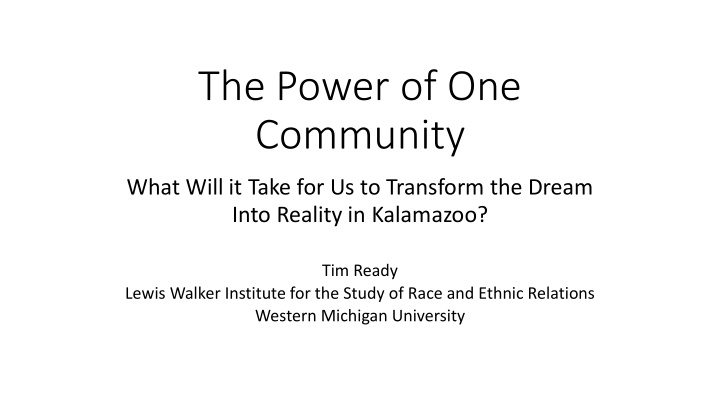



The Power of One Community What Will it Take for Us to Transform the Dream Into Reality in Kalamazoo? Tim Ready Lewis Walker Institute for the Study of Race and Ethnic Relations Western Michigan University
Progress of Kalamazoo’s Ninth Grade Cohort of the Graduating Class of 2007 to Post-Secondary Degree Attainment After Six Years, by Race 450 Ninth Grade Cohort 400 382 HS Grads 350 325 Promise Eligible 300 Promise Users 274 258 Any PS Credential 240 250 219 219 Bachelor's Degree 185 200 150 121 108 100 68 47 45 44 50 31 23 12 10 0 White Black Other * The source for the number of students in the ninth grade cohort of the high school graduation class of 2007 is the Michigan Department of Education. The source for all other data is the Kalamazoo Promise.
Percent of the Ninth Grade Cohort for Kalamazoo’s High School Graduation Class of 2007 that Attained a Post-Secondary Degree within Six Years, by Race 40% 37% 35% 33% Any Credential Bachelors Degree 30% 25% 23% 20% 18% 18% 15% 15% 11% 10% 6% 5% 0% Black white Other Total Source: Michigan Department of Education and the Kalamazoo Promise
Four Year High School Graduation Rate by Race and Gender, Kalamazoo Public Schools, 2015 90% 84% 77% 80% 69% 70% 60% 52% 50% 40% 30% 20% 10% 0% female male female male black white * Mischooldata.org
Percentage of KPS Students in Special Education by Race/Ethnicity, 2013 14% 13% 12% 10% 8% 7% 6% 6% 4% 3% 2% 0% Black Males Black Females White Males White Females * Civil rights data. US Dept. of Education, Office for Civil Rights
Percentage of KPS Students Suspended from School by Race and Gender, 2013 50% 45% 45% 40% 35% 30% 24% 25% 20% 15% 12% 10% 6% 5% 0% Black Males Black Females White Males White Females * Civil Rights Data. US Dept. of Education, Office for Civil Rights
School to Prison Pipeline? Kalamazoo County Has Highest Juvenile Disproportionate Minority Contact Arrest Rate of All Urban Counties in Michigan 7.4 to 1 Arrests per 1,000 Juveniles in Michigan's Urban Counties, 2013 35 • A Black youth in 28.8 30 25.9 Kalamazoo County (age 25 10 to 16) is 7.4 times as 20 17.4 17.2 15 likely to be arrested than 11.9 11.2 10.3 8.8 10 a white youth (2013). 5 0 Kalamazoo Kent Wayne Genesee Macomb Saginaw Oakland Ingham * Michigan Committee on Juvenile Justice
Black Kalamazoo Residents in Poverty, 2013 Black Kalamazoo Residents in Poverty • 7,126 or 44% of all black residents of Kalamazoo are poor. • Only 18 cities in the US have a higher black poverty rates Black Kalamazoo Youth in Poverty • 2,395 or 57% of black children in Kalamazoo are poor • Only 33 of 224 US cities with at least 15,000 black residents have higher poverty rates for black children * Tabulation of American Community Survey data by the WMU Walker Institute
Schooling is ju just one part of f a larger process by which kids learn what they need to do to become competent and respected members of f their communities Most of this takes place during the 89% of the time that kids’ spend outside of school
How Do Kids Learn to become competent and respected members of their communities? Community Members Schools • What more must public officials • What more can schools do to and community leaders do to promote kids’ success while close the opportunity gap and respecting cultural differences? overcome structured inequality and institutional racism? • What can each of us do to become more effective stakeholders in our own futures?
Shared Prosperity Kala lamazoo GOALS • Better access to well paying jobs • Strong, economically secure families • The healthy growth, development and learning of children and youth
Recommend
More recommend